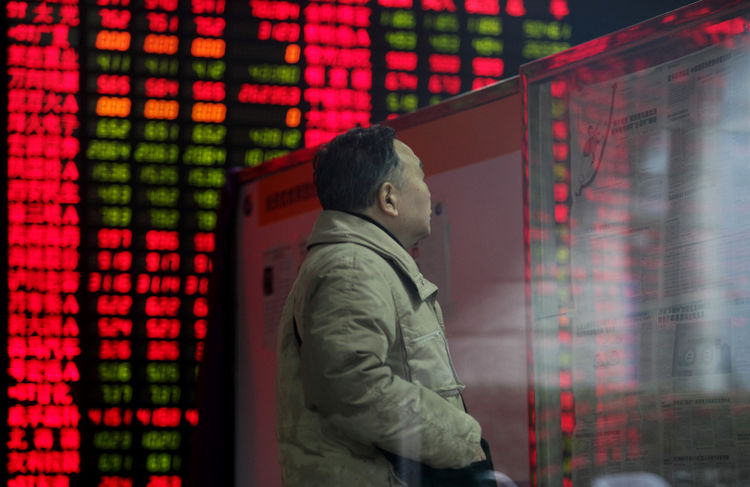Global stocks held near a one-year high as rising oil prices bolstered investor sentiment following disappointing data in the world’s three largest economies.
U.S. equity index futures advanced, after retreating from a record in the last session as a report showed American retail sales stopped expanding in July. The Topix index fell and the yen strengthened after Japan announced slower economic growth than analysts forecast. The Shanghai Composite Index jumped by the most since May as takeover speculation outweighed Chinese figures showing a slump in new lending. The yuan fell for the first time in a week and U.S. crude climbed for a third day.
Global equities are trading near a one-year high as evidence of uneven growth in the world’s biggest economies both unnerves traders and fuels optimism that central banks will come to the rescue by way of stimulus. The probability that the Federal Reserve will increase interest rates this year eased to 42 percent in the futures market on Friday following the release of the U.S. retail sales figures, from 49 percent a day earlier.
“The U.S. economy may have lost a bit of momentum on its way up,” said Shoji Hirakawa, chief global strategist at Tokai Tokyo Research Center. “Still, weak numbers mean concern over tightening recedes.”
Stocks
The Stoxx Europe 600 Index was up 0.1 percent as of 8:24 a.m. London time. William Hill Plc declined 1.3 percent after the U.K.’s biggest bookmaker rejected an increased offer from 888 Holdings Plc and Rank Group Plc. The bidders were down 2.2 percent and up 2.8 percent, respectively.
The MSCI Asia Pacific Index fell less than 0.1 percent, after rallying 3.1 percent last week. Markets in South Korea and India were shut Monday for holidays.
The Topix index lost 0.5 percent as Japan posted an annualized expansion for the second quarter of 0.2 percent, below the 0.7 percent projected by economists.
Officials in Asia’s second-largest economy are struggling to ignite price growth, with the central bank running negative interest rates and an unprecedented asset-purchase program, and the government also bolstering fiscal stimulus.
Hong Kong’s Hang Seng Index climbed 0.8 percent to a nine-month high after government data showed the economy expanded in the second quarter at the fastest pace since 2001. The Shanghai Composite Index advanced 2.4 percent to its highest since January after stake purchases by China Evergrande Group spurred takeover bets among property developers. The Shenzhen Composite Index climbed by the most since June after the Hong Kong Economic Journal reported that a proposed exchange link with Hong Kong will be announced as soon as this week and start in December.
“The road ahead may be bumpy but Asian equities ex-Japan are relatively undervalued, under-owned and under-appreciated,” said Vasu Menon, vice president for wealth management research at Oversea-Chinese Banking Corp. in Singapore. “It could do better than other regions over the next few years once we see greater stability in China and greater clarity with Fed policy.”
Futures on the S&P 500 Index added 0.2 percent, after the U.S. benchmark slipped 0.1 percent in the last session.
Currencies
The Bloomberg Dollar Spot Index, a gauge of the greenback’s strength, retreated 0.2 percent to levels last seen in June. The yen advanced 0.2 percent, reversing an earlier loss. Russia’s ruble climbed 1.1 percent, leading gains among the currencies of oil-exporting nations.
The yuan weakened 0.14 percent to 6.6425 per dollar in Shanghai, after gaining 0.4 percent over the last four trading days. China’s broadest measure of new credit increased in July by the least in two years, a report showed late Friday. Data earlier that day showed factory output, retail sales and fixed-asset investment all slowed in Asia’s biggest economy.
Thailand’s baht reversed earlier losses to trade 0.5 percent stronger after the government reported better-than-expected economic growth. Gross domestic product expanded 3.5 percent in the three months through June from a year earlier, more than the 3.3 percent increase forecast in a Bloomberg survey.
West Texas Intermediate crude climbed as much as 1.2 percent to $45.02 a barrel. It jumped 6.4 percent last week, its best performance since April, as Saudi Arabia signaled that it’s prepared to discuss stabilizing markets at informal discussions being held by the Organization of Petroleum Exporting Countries in September. Venezuela’s oil and foreign ministers will visit producer countries to lobby for price increases ahead of the talks, President Nicolas Maduro said.
Gold rose for the first time in three days, gaining 0.4 percent. The reduced likelihood of a Fed rate hike is a positive for precious metals as they don’t pay interest.
Bonds
The yield on U.S. Treasuries due in a decade fell one basis point to 1.50 percent, after dropping by five basis points on Friday. The rate on similar-maturity Chinese debt dropped was steady at 2.66 percent, the lowest in China Bond data going back to 2006.

 Naira4 weeks ago
Naira4 weeks ago
 News4 weeks ago
News4 weeks ago
 Naira4 weeks ago
Naira4 weeks ago
 Travel3 weeks ago
Travel3 weeks ago
 Jobs4 weeks ago
Jobs4 weeks ago
 Naira3 weeks ago
Naira3 weeks ago
 Naira3 weeks ago
Naira3 weeks ago
 Investment4 weeks ago
Investment4 weeks ago






























